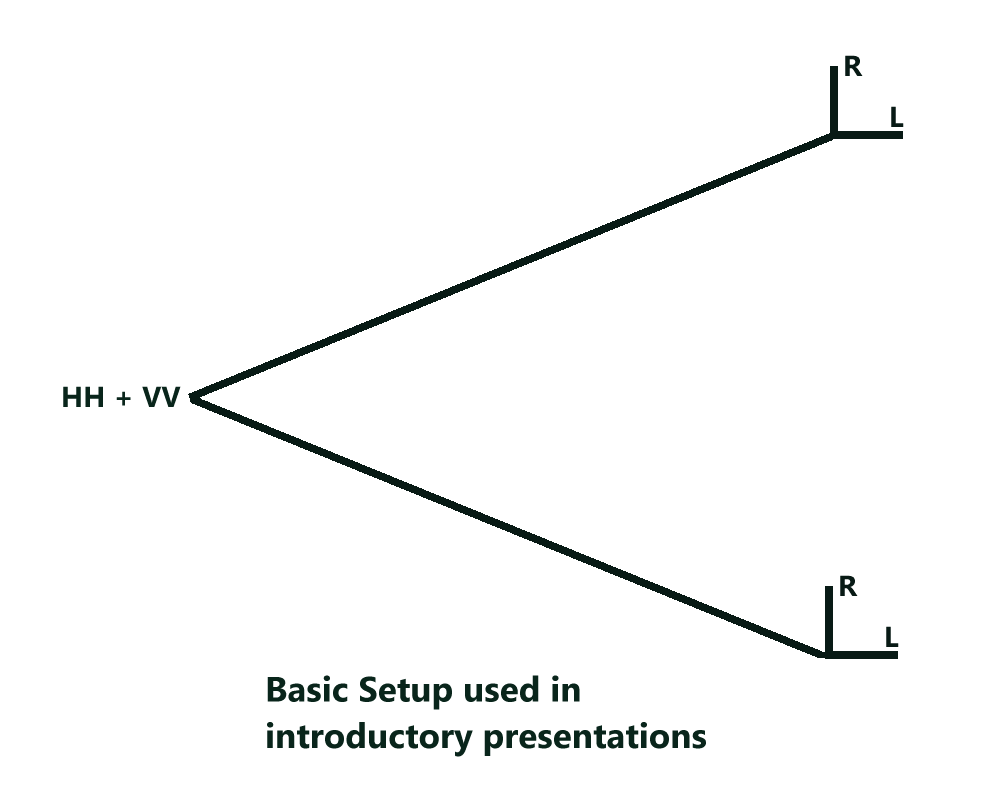This is the setup used in the Quantum Entanglement and Spooky Action at a distance video presentation with John Bell.
The basic experiment is a pair of entangled photons being put through two different detectors. The simple version uses the Type -2 detectors of the Mermin Rhetorical homework problem. The axis are shown in the diagram below. Let H and V be polarization eigenstates for horizontally and vertically polarized photons, and let R and L be polarization eigenstates for two orthogonal right and left directions at 45 degrees so that



The source produces two photons in the polarization state:
 this is considered an entangled state because it does not contain a full contingent of states – there are not VH and HV terms.
this is considered an entangled state because it does not contain a full contingent of states – there are not VH and HV terms.
Thus if both the detectors are type-1 the detectors will show the same results. Either both H or both V.
Substituting the axis transforms:





And thus the detectors either see both R or both L
Note how you can not get the critical cancellation without
- Both UU AND VV are required to get cancellation. Without both you do not get the critical term to cancel. Do we take that to mean they're both ghosted into the detector? This is more overt in the descriptions with the answer being yes. They call it a superposition in state.
- Both photons are depicted as being in each detector. You need both U & U and V & V for the term to cancel. Do we take this to mean both photons are ghosted into each detector? Again it seems to function equivalently to a superposition. This time in space.
- I take from the above observations that just like in the two slit experiment with single electrons dribbled in – the effect observed will be not be seen should we force a measurement of any of these quantities.

Quantum Mechanics Table of Contents TOC
- Quantum Mechanics Table of Contents TOC
- ASU Quantum Mechanics for Engineers 434 Notes from Year 2001
- Book: Advanced Quantum Mechanics – Freeman Dyson
- Book: Notes on Quantum Mechanics
- Quantum Mechanics Entanglement and Quantum Computation Summary List
- Quantum Mechanics and Entanglement Experiment with Single Photon Detector
- Summary Outline of Richard Feynmans Thesis – Framework for learning QED and Quantum Mechanics in general
- Quantum Computing Video strips down computing mechanics explanation to minimum
- Quantum Mechanics Computing for Computer Scientists
- Quantum Mechanics Money from Knots
- Quantum Mechanics Logic
- Video: Erann Gats explanation of quantum entanglement, measurement and interpretations
- Leonard Susskind Quantum Entanglement Lecture 2006
- Quantum Mechanics Entanglement and Spooky Action at a distance
- Quantum Computing Parallelism Explained
- On the Theory of Quanta Louis-Victor de Broglie 1892-1987
- Entangled-Light-Emitting Diode
- PAM Dirac Lectures in New Zealand 1975
- Leonard Susskind Lecture Series Play Lists
- Video: Spooky Actions At A Distance?: Oppenheimer Lecture – David Mermin – and Rhetorical Homework Problem Solution
- Lectures on Quantum Computation by David Deutsch – Includes Best Grover Search Algorithm Explanation Unit 6
- Basic Polarized Photon Entanglement Experiment
- Private: Quantum Computing Book Collection
- Video: KITP Lecture : Putting Weirdness to Work: Quantum Information Science
- Private: Derivation of the Planck Relation and Maximum Entropy Principle
- Derivation of Nyquist 4KTBR Relation using Boltzmann 1/2KT Equipartition Theorem
- Heuristic method of understanding the shapes of hydrogen atom electron orbitals
End TOC

0 Comments